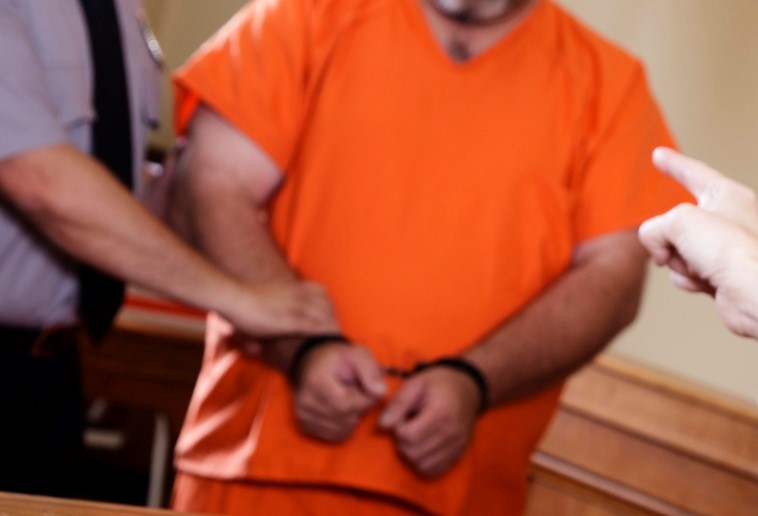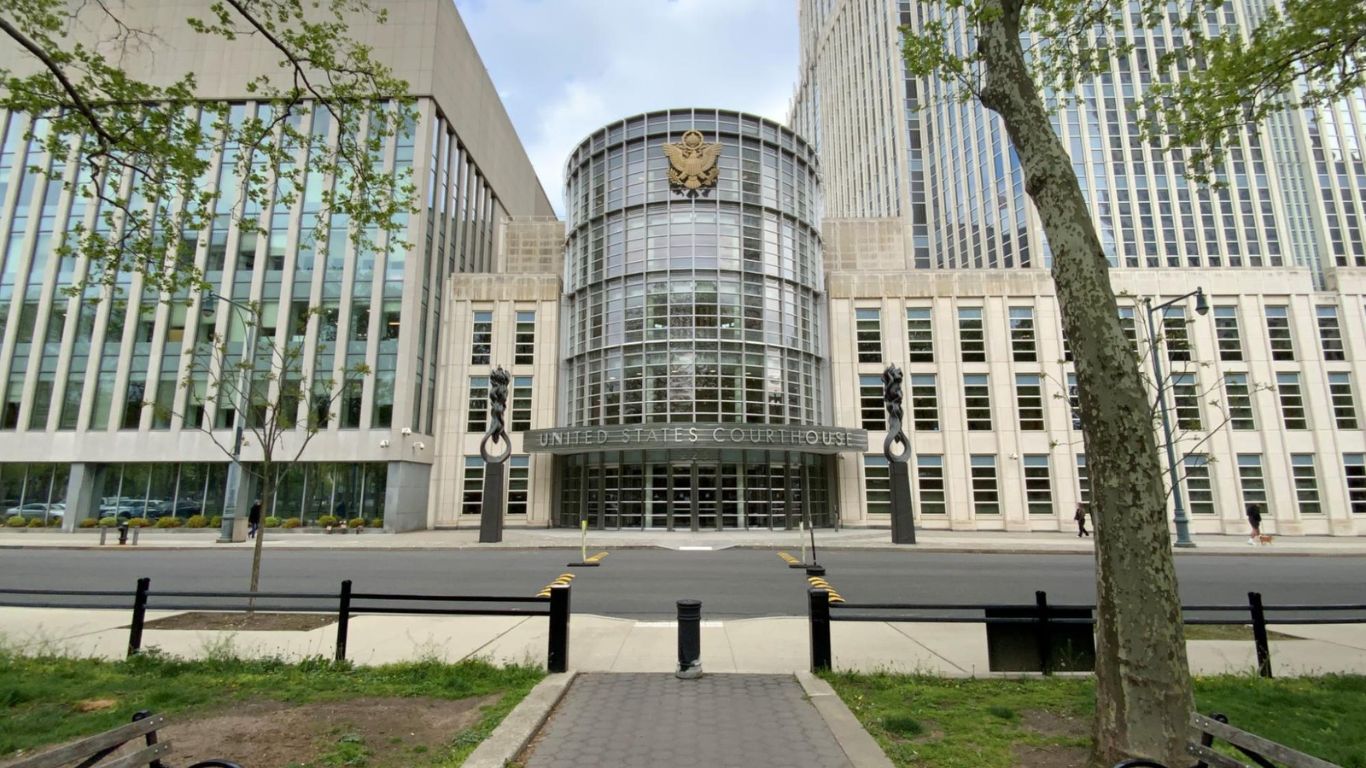Although unnerving, I often meet up with prisoners (in-custody defendants) face-to-face while waiting for an elevator in courthouses. Typically, when this happens, the elevator doors open, and I am directed by court security personnel to step aside while the prisoners are escorted out of the elevator. I have been in many courthouses where the jingling of shackles is a sign to clear public hallways as prisoners pass to and from courtrooms. These occurrences are all too common in courthouses. However, as presented in this blog, some measures can be taken to secure courthouses, even if the facility cannot accommodate separate circulation pathways.
A Critical Design Feature
Having secure and separate circulation patterns for judges, court employees, prisoners, and the public is a contemporary courthouse's most critical security design feature. Unfortunately, it is often the most problematically deficient characteristic of many older and historic courthouses.
The Fentress database shows that of the nearly 1,000 total court facilities we have assessed to date, 61% still need circulation patterns to courtrooms that provide secure, utterly separate access for judges, court personnel, prisoners, jury members, and the public.
In older courthouses, particularly in historic courthouses, remediate deficient circulation conditions may be architecturally or structurally impossible. Inflexible overall courthouse layouts or immovable masonry-bearing walls may preclude any improvement. Still, secure circulation is essential to protect all individuals in these courthouses. Fortunately, there are acceptable and effective options to avoid a convicted drug dealer and a juror meeting face-to-face in your historic courthouse hallway.
What are the Options?
When separate access cannot be established through an improved architectural layout, it will be necessary for court security personnel to control circulation manually. The specific security measures required to accomplish this are most effectively developed case-by-case through a coordinated effort between courthouse planners and court security staff. Generally, the optimal solutions will be combining court security staff, security hardware, and improved security technologies.
Let’s consider some of the specific options.
Court Security Personnel Procedures
Prisoner Movement. The absence of a dedicated secure circulation route for the movement of prisoners between the central cellblock and the courtroom or courtroom holding cell is the most common deficiency I see in the older courthouses I have assessed. In these situations, the only viable solution is for court security personnel to escort prisoners through public hallways. To safely use this alternative, management of prisoner movement must be augmented with additional security personnel to control public access along the shared circulation paths. Hence, there is no possibility of interaction between prisoners and the public.
Juror Circulation. It is not uncommon in older courthouses where restricted circulation is not available for jurors to move between jury suites and courtrooms to instead have jurors use public hallways. To assure security for jurors, court security personnel must accompany their movement. Again, to avoid undesirable interaction with prisoners, this responsibility must also include coordination with prisoner movement by other members of the courthouse security organization.
Security Hardware
CCTV and Duress Alarms. Judges are often required to use public corridors, stairways, or elevators between chambers and courtrooms or between chambers and other courthouse areas, such as libraries or parking. In these instances, CCTV cameras linked to the courthouse security center monitors should be installed along the entire circulation path to monitor the judges’ movement. The most complete application of CCTV cameras that I have seen was in a historic courthouse. In this instance, extra precautions were taken by installing duress alarms at select locations linked to the courthouse security center.
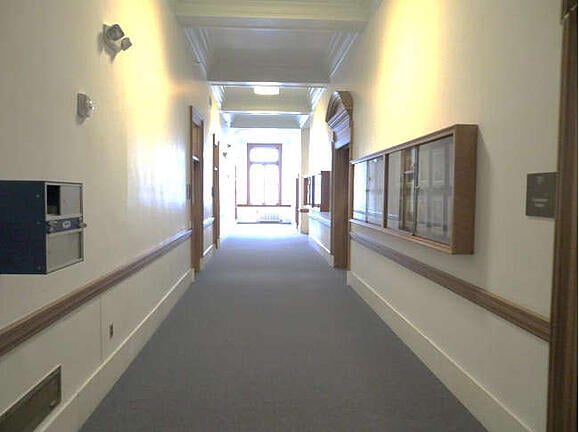
CCTV in Public Corridor Used by Judges
Door Lockouts. I have visited several older courthouses where restricted judges’ corridors and elevators are used to move prisoners between the central cellblock and the courtroom or courtroom holding cell to avoid public hallways. A formalized process has been established to notify judges and judicial staff before prisoner movement. Most importantly, a door lockout system managed by the courthouse security staff has been used where all doors bordering the restricted corridor, including elevator doors, are locked when prisoner movement occurs. This fail-safe lockout approach is required to prevent ill-timed or wholly unintentional entry by judges or judicial staff during prisoner movement.
Security Technologies
Wireless CCTV Cameras. I recently toured a security control center in a Missouri courthouse that had significantly expanded coverage of the courthouse due to the new generation of wireless CCTV cameras. This new generation of cameras permits the efficient installation of additional cameras for enhanced coverage without needing wall or ceiling modifications to accommodate installing new cables back to the security monitoring center. This is a particularly advantageous solution for historic courthouses where architectural limitations have sometimes constrained the number or location of needed cameras.
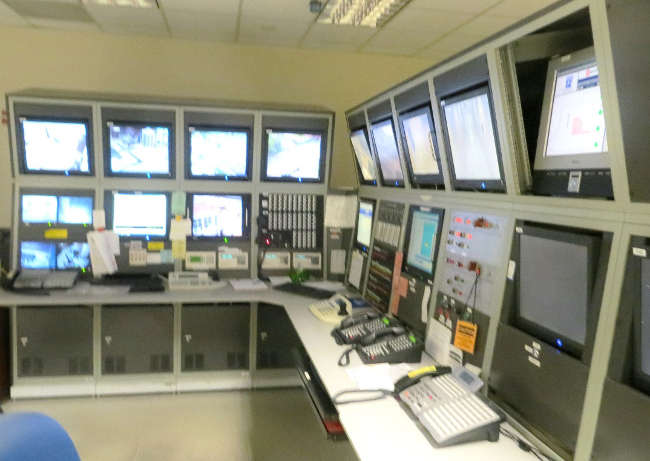
Expanded Courthouse Security Monitoring Center
Central Electronic Door Controls. I have found increased use of centrally controlled, electronic door lockout systems for restricted judges’ corridors (as discussed above in “Door Lockouts”). In these systems, each controlled door is locked and unlocked electronically from a central access control panel in the courthouse security monitoring center. The access control panel is managed by a dedicated access control computer, which may be used to manually or automatically control the time required to lock and unlock selected doors. The same control system is also connected to the elevator doors serving the judges’ restricted corridor to control access on a floor-by-floor basis.
In the courthouses where I have seen this application used, doors and elevators along the judges’ restricted corridor are locked and unlocked by a court security officer in the security control center. The officer coordinates with judges, judges’ staff, and court security officers engaged in the movement of prisoners.
I have similarly watched the expanded use of electronic egress door hardware and panic door bars, which are designed to improve the balance between egress requirements and security in older courthouses.
Emergency Egress Controls. Because building codes require at least two means of egress from each floor, the layout of older and especially historic courthouses often requires public emergency egress routes to use judges’ restricted corridors. Electronic door hardware integrated into the fire alarm system can limit authorized personnel using key cards to access emergency egress corridors during normal building operations. When emergency alarms are activated, the locks automatically disengage, allowing public use of the judges’/egress corridors.
An alternative system, shown in the following photo, allows a specific door to be unlocked after a 30-second delay in an emergency. Since such doors are simultaneously recorded in the courthouse security control center, court security personnel can provide an immediate response in the instance of improper use.
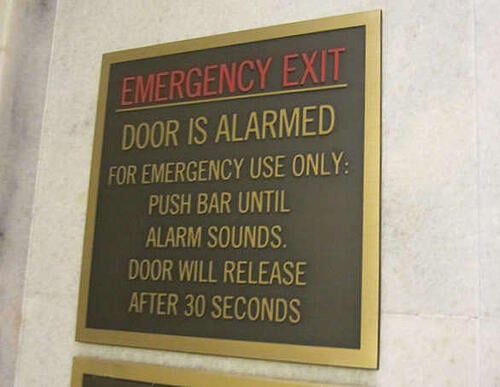
Notice in a Judges’ Corridor Used for Egress
Most Effective Applications
The following matrix summarizes which alternative security measures would most effectively manage each potential mixed circulation pattern.
The five columns at the right of the matrix list the multiple security options discussed in this article that may be used as alternatives to separate diverse circulation patterns architecturally. The four rows at the bottom of the matrix list the most problematic situations where incompatible circulation is combined. The boxes with an X indicate the security option that would most effectively address the incompatible circulation situation.
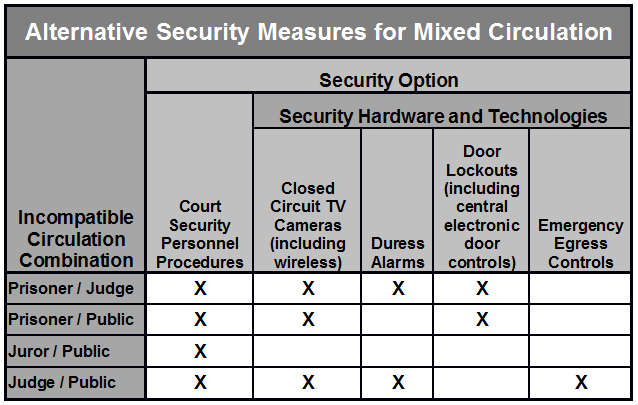
Moving Forward
The personnel procedures, equipment, and technology described above represent courthouse security measures that have actually and effectively been used as alternative measures for providing secure circulation in older courthouses. However, other options might be used. Security technology and equipment continue to evolve, and with these more advanced and improved tools, court security personnel can revise and improve their procedures.
Although a complete separation of circulation patterns for judges, court employees, prisoners, and the public is always the preferred solution for any courthouse, security for all its occupants is the goal that must be and can be achieved, although sometimes creatively.
__________________________________________________________________



